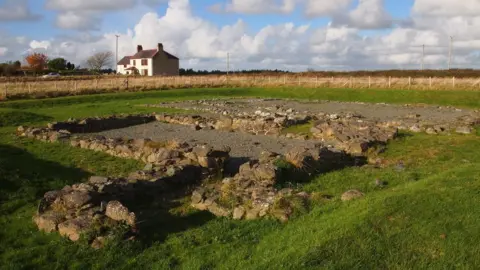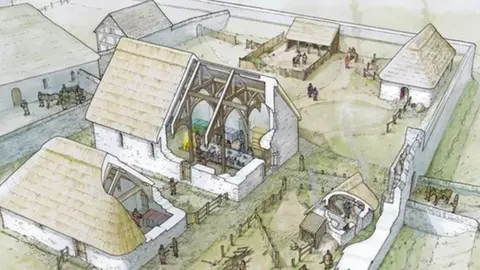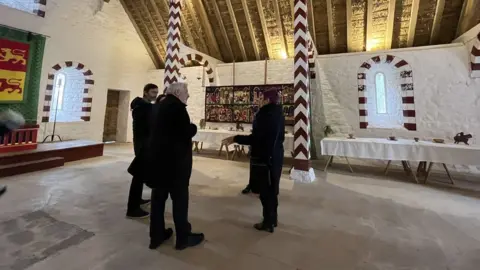Llys Rhosyr medieval court of Welsh princes bought by Cadw
 Chris Andrews | Geograph.org.uk
Chris Andrews | Geograph.org.ukOne of the royal courts of the Princes of Gwynedd has been bought by Wales' historic buildings organisation, Cadw.
Llys Rhosyr, near Newborough, Anglesey, is the only court of the Welsh Princes in Wales with visible remains that can be visited by the public.
It was "significant" in the Middle Ages and believed to have been used to administer justice and collect rents.
Other similar sites are known from documents or have been suggested from partial excavations.
But Llys Rhosyr is the only undefended court of the Welsh princes confirmed through archaeological excavation.
The site, which was bought for £17,000, has been designated as a scheduled monument by Cadw.
Llys Rhosyr is believed to have been in use between 1237 and 1314 and was occupied when the princes of Gwynedd were dominant in the country.
It was abandoned in the aftermath of the conquest of north Wales by Edward I, when it fell into English hands.
The site is currently open to the public and free to visit.

 National Museum Wales
National Museum WalesWhat was Llys Rhosyr?
- Llys Rhosyr was one of the royal courts of Llywelyn Fawr - Llywelyn The Great (1172-1240) - who was prince of Gwynedd in the 13th Century, succeeded by his son Dafydd ap Llywelyn
- The princes ruled by touring their realm and sitting in courts in small administrative areas called "commotes". Each had a llys (court)
- Llys Rhosyr was at the heart of the Menai commote near where Newborough parish church is now
- King Edward I's conquest of 1282 led to Rhosyr being largely abandoned
- Around 1330 a sandstorm buried the site beneath sand dunes
- It was discovered in 1992 by archaeologist Neil Johnstone
- The site was partially excavated, revealing a large main hall and a building thought to have housed the prince's private rooms
- A reconstruction of the site built at St Fagans in 2018, reimagines what the great hall would have looked like
- Sources: Friends of Llys Rhosyr | St Fagans National History Museum


"I am extremely proud that we have been able to purchase this significant site in Welsh history," said Dawn Bowden, deputy minister for arts and sport.
"Cadw will now start work to ensure the site is properly conserved and accessible for all to appreciate," she said.
Two of the court buildings from Llys Rhosyr have been recreated at St Fagans National Museum of History in Cardiff and called Llys Llewelyn.
"Visiting Llys Llywelyn in St Fagans has provided a fascinating insight into what the original site in Anglesey could have looked and felt like - and how important it was to the history of Wales" she said.
The earliest evidence for royal association at Llys Rhosyr is recorded in the Brut y Tywysogion, The Chronicle Of The Princes.
This documents on April 10 1237 that Llywelyn ap Iorwerth (the Great) witnessed a charter for a grant of land to the Augustinian Community of Ynys Lannog (Puffin Island).
Buildings at Llys Rhosyr are thought to date to the beginning of the 13th Century.

In 1992, the Gwynedd Archaeological Trust began excavation work at the site which uncovered the outlines of the walls, including a surrounding enclosure wall and foundations.
The work, which took place over a number of years, also discovered foundations and lower walls of three large buildings, possibly the hall, a chamber and storage barns.
Llys Rhosyr fell into English hands following the conquest of north Wales by Edward I and the subsequent death of Llywelyn ap Gruffydd - the last Welsh Prince.
Edward I visited the site in 1283 and gave the estate to his wife, Eleanor of Castile, and the court of north Wales continued to be maintained until the first half of the 14th century.
The final coin from Llys Rhosyr dates to 1314.
Cadw is responsible for protecting 131 monuments across Wales, including those built following Edward I's invasion of north Wales.
Cadw boss Gwilym Hughes said: "There are already significant castles in our collection of monuments built by the independent Welsh princes: Dolbadarn, Dolwyddelan, Criccieth and Castell y Bere, but this is the first site in Cadw's care that is neither military nor religious.
"Llys Rhosyr tells a very important part of our history from some eight or nine hundred years ago," he said.
